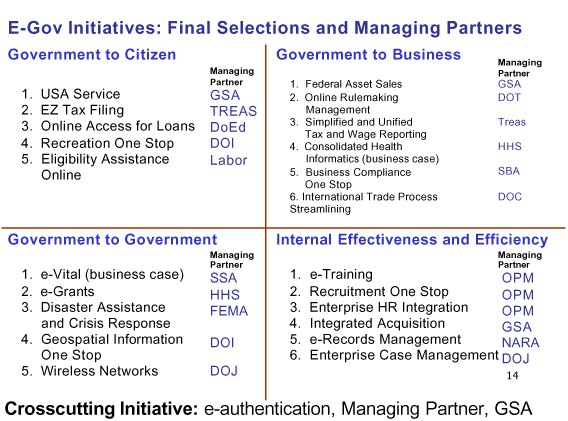Office of Management and Budget
News Release
| FOR IMMEDIATE RELEASE |
2001-54 |
OMB Outlines New Federal E-Government Strategy
23 Initiatives Will Help Improve Customer Service and Efficiency
Washington, DC, October 25, 2001 -- Office of Management and
Budget Director Mitchell E. Daniels, Jr. outlined today a new E-government
plan that will accelerate federal government improvements in effectiveness,
efficiency, and customer service. The strategy, adopted by the President’s
Management Council (PMC) in October, implements the "Expanding Electronic
Government" reform outlined in the President’s Management Agenda.
"As a nation we’re already the leader in global information technology.
With these reforms, citizens will be able to demand and expect the same level
of IT quality from their government that the private sector provides its customers,"
said Director Daniels.
The plan, developed by the E-Government Task Force established in August
by Director Daniels, will create multi-agency teams to develop and deploy 23
major E-Government initiatives. These measures will use Internet-related
technologies to accelerate and streamline service delivery to citizens,
reduce paperwork burdens on business, improve management and responsiveness
of joint federal-state-local programs, and apply commercial best practices
to improve government operating efficiency. Another initiative will focus
on computer security, disaster response, and intergovernmental communications
for public safety.
The 23 E-Government initiatives cut across many federal agencies and
reflect partnership with state and local governments. The initiatives are
designed to maximize federal government productivity gains from technology,
eliminate redundant systems, and significantly improve government’s quality
of service for citizens and businesses over the next 18 to 24 months.
Mark Forman, executive director of the task force, said "We had more than
70 experienced, knowledgeable, and high-level individuals from 30 agencies
working to identify high payoff initiatives that can be rapidly deployed.
We now have an action plan and roadmap to E-Government that the PMC has
endorsed. Each initiative reflects multiple current investments, and I look
forward to working with agencies in a partnership approach to reduce
redundancy and improve citizens’ return on investment. I am proud of the
accomplishments of this task force, which provided a strong beginning to
this important effort."
The E-Government Task Force kicked off the project on August 9.
By September 5th, 80 interviews were conducted with senior federal
and state officials, including political appointees and career civil
officials. More than 175 e-mail responses were also received, and more than
269 information technology "projects" were uncovered.
The task force also identified that the federal business architecture
comprises 28 major lines of business and discovered that nearly 500 business
lines are operating in the agencies, which equates to an average of 19 agencies
performing each line of business. Therefore, the task force is developing a
high-level business case to evaluate each initiative. As a result of simplifying
business processes and unifying government operations around citizen needs,
each E-Government initiative creates an order of magnitude improvement in
efficiency and effectiveness of government operations. Overall, the
initiatives represent an opportunity to free-up billions of dollars of
federal spending, while accelerating government response times from weeks
down to minutes.
The task force identified five key areas that require executive
attention to enable federal E-Government success: agency participation; lack
of architecture decisions; security and privacy concerns; resource availability;
and resistance from key stakeholders. The PMC agreed to provide the
executive leadership and management attention needed to overcome these
barriers. In addition, the PMC endorsed the task force’s federal computer
security and architecture recommendations.
Agencies will now begin the difficult work of finalizing business
cases and implementing the recommendations through a governance structure
that includes "managing partners" working in cooperation with other partner
agencies, measuring progress, and coordinating with interagency councils/steering
groups on a portfolio of improvements cutting across the federal government.

-- 30 --
|

